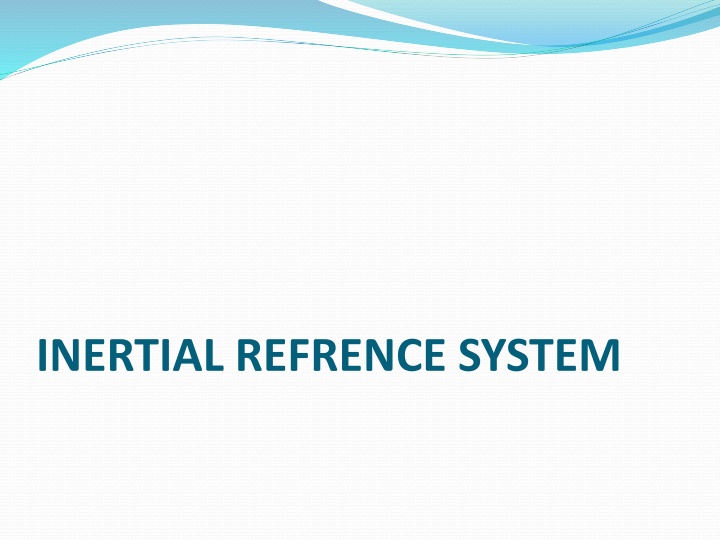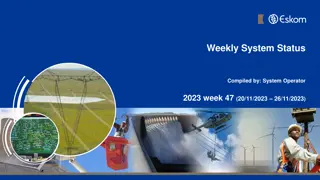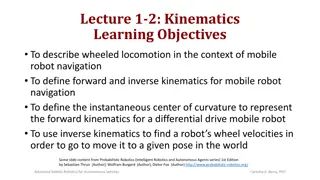INERTIAL REFRENCE SYSTEM
Inertial Reference Systems (IRS) provide vital inertial navigation data, employing advanced technology like ring laser gyros for precise sensing. The system integrates multiple components to deliver essential flight control and navigation data, including position, attitude, heading, wind speed, velocity, and more. IRS outputs are crucial for displaying and managing flight parameters effectively. The system utilizes accelerometers and laser gyros in a strap-down configuration to ensure accurate computations and reliable performance.
Download Presentation

Please find below an Image/Link to download the presentation.
The content on the website is provided AS IS for your information and personal use only. It may not be sold, licensed, or shared on other websites without obtaining consent from the author.If you encounter any issues during the download, it is possible that the publisher has removed the file from their server.
You are allowed to download the files provided on this website for personal or commercial use, subject to the condition that they are used lawfully. All files are the property of their respective owners.
The content on the website is provided AS IS for your information and personal use only. It may not be sold, licensed, or shared on other websites without obtaining consent from the author.
E N D
Presentation Transcript
The inertial reference system (IRS) provides inertial navigation data to user systems. It uses a ring laser gyro instead of the conventional rate gyro to sense angular rate about the roll, pitch and yaw axes. The system is termed strap down since its sensors are, in effect, directly mounted to the airframe. The inertial reference system (IRS) includes two inertial reference units (IRU), one inertial system display unit (ISDU), one mode select unit (MSU), one master caution unit (MCU), two digital/analog adapters (DAA) and two radio digital distance magnetic indicators (RDDMI). The IRS provides the inertial navigation data and the inertial flight control data to other systems.
The main function of each IRU is to sense and compute linear accelerations and angular turning rates about the airplane's pitch, roll, and yaw axes. This data is used for pitch and roll displays and navigational computations. Each IRU contains three laser gyros and three accelerometers. These sense angular rates and linear accelerations, respectively. The sensed data is resolved to local vertical coordinates and combined with air data inputs to compute the following:
(1) Position (latitude, longitude) (2) Attitude (pitch, roll, yaw) (3) True and magnetic heading (4) Wind speed and direction (5) Velocity (6) Accelerations (7) Angular rate data (8) Altitude
The IRS outputs are displayed on the flight instrument system displays. They are also displayed on the flight management computer system control display unit (FMCS-CDU) Preselected parameters are also displayed on the inertial system display unit (ISDU).
A. General The IRS provides basic heading and attitude reference accomplished through computations based on accelerometer and laser gyro sensed signals. Three accelerometers and three laser gyros are used. The accelerometers and laser gyros are of the strap-down type and are positioned in the inertial reference units so that they are oriented along each of the three axis of the airplane. This orientation allows the IRU to sense accelerations along and rotation about each of the three axis.
Computer manipulation of the signals from all six sensors provide the basic heading and attitude reference signals along with present position, accelerations, ground speed, drift angle and attitude rate information. The first requirement which must be met forproper IRS operation is alignment. IRS alignment basically determination of local vertical and initial heading. consists of
B. Alignment IRS alignment consists of determining local vertical and initial heading. Both accelerometer and laser gyro inputs are used foralignment. The alignment computations use the basic premise that the only alignment are due to the earth's gravity; the only motion during alignment is due to the earth's rotation. Accelerations due to perpendicular to the earth's surface and thus define the local vertical. accelerations during gravity are always
This local vertical is used to fix attitude data so that it is accurately referenced tovertical. Initially, only a established. Once vertical is established, the laser gyro sensed components are used to establish the heading of theairplane. As the alignment continues, both the vertical reference determinations are maximumaccuracy. the coarse vertical is earth rate and the heading tuned fine for























